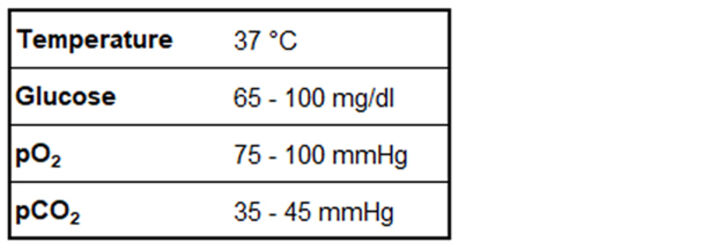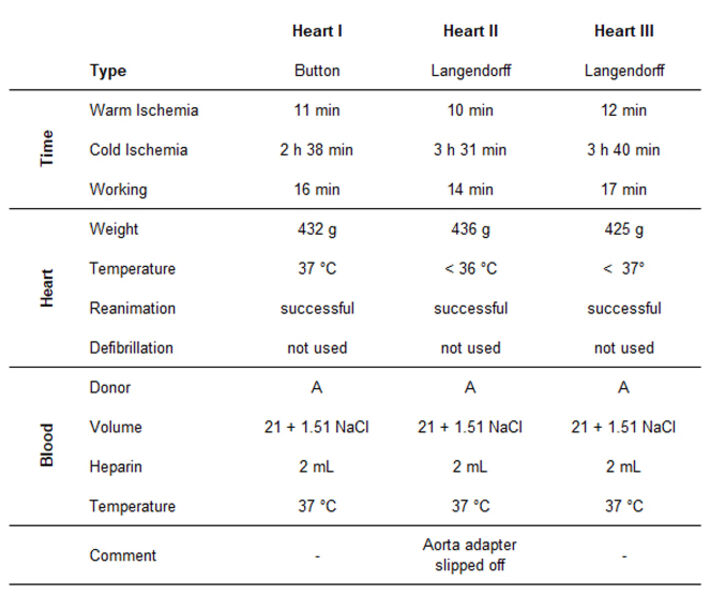Watch tutorials, webinars and informative videos about PreSens optical sensor systems.
Monitoring in an Isolated Perfused Heart Test Stand with PreSens Optical Sensors
O2, CO2 and Glucose Flow-through Cells Integrated in a Blood Perfusion System
Daniela Obermaier1 & Giuliano Giacoppo2
1PreSens Precision Sensing GmbH, Regensburg, Germany
2Regensburg Center of Biomedical Engineering, University of Applied Sciences, Regensburg, Germany
During long-term application of artificial lungs (Extra Corporeal Membrane Oxygenation - ECMO) different complications, like blood clotting, cell destruction (hemolysis), or bleeding tendency of patients, can occur. Whether these complications are caused by the mechanical blood pump or by the flow in the ECMO is currently unclear. In order to investigate the formation of coagulation and hemolysis, a test stand for an isolated, perfused animal heart, which is an ideal physiological blood pump, is being developed. Thus, the differentiation of fluid mechanical processes, biocompatibility problems as well as pump-induced phenomena is possible.
Each year approx. 600,000 patients die of lung diseases in the EU, of which more than half of the deaths are related to 'Chronic Obstructive Pulmonary Disease' (COPD). There are currently 210 million people worldwide affected by this disease and the number is steadily increasing. Once the conventional therapy in patients with acute life-threatening respiratory dysfunction has failed, usually an ECMO is applied. The ECMO takes over the function of the heart and lungs and thus supports the patient, which can give the cardiovascular system more time to recover. However, ECMO therapy was originally developed for short-term use. In clinical use there is a tendency to apply ECMO in long-term treatment of patients suffering from acute lung diseases, and corresponding complications like increased coagulation, hemolysis, infection and bleeding tendency may occur.
The study aims to investigate, if the cause of these complications arises in the necessary blood pump or in the oxygenator itself. Therefore, we develop a medical ECMO test stand with an isolated perfused heart as the blood pump. This test stand allows differentiating the origin of the damage. The heart has been optimized to perfection by nature for centuries, so it can be assumed, that in physiological conditions no damage should be caused by this blood pump. If increased hemolysis and blood clotting occurs under these experimental conditions, this is most likely an indicator, that the flow situation in the oxygenator is not optimal.
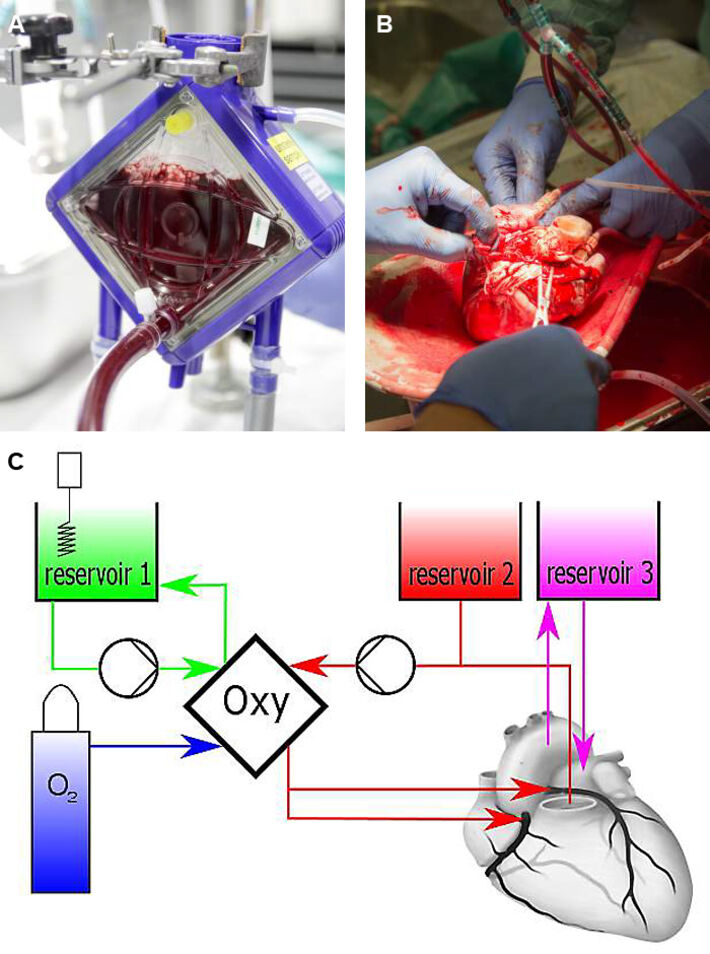
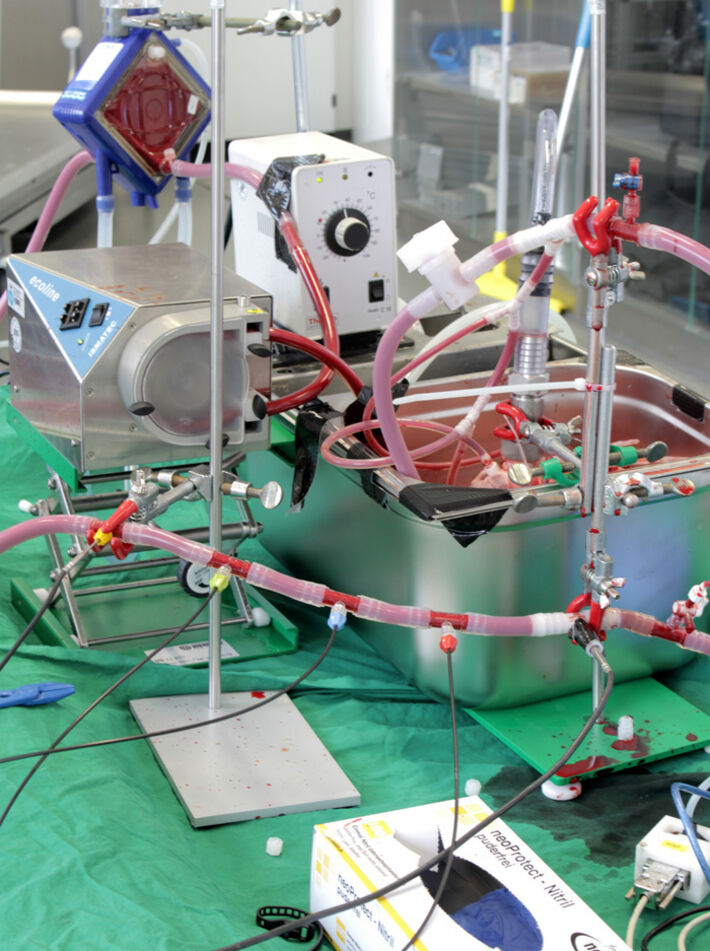
Materials & Methods
Three pig hearts (Fig. 3) were used in these experiments; since they have a great anatomical and physiological similarity to a human heart they represent a good experimental alternative. Furthermore, pig hearts are easy to obtain, as they are often treated as waste products by butchers. To prepare the pig heart for the experiments, it was immediately treated after slaughter according to the current guidelines for transplantable hearts. This required an immediate cooling to 4 °C and rinsing the heart vessels with cardioplegic solution. By rapid cooling (so-called warm ischemia time) the metabolism and oxygen consumption of the heart is significantly reduced, and overall an ischemia time, i.e. a time without blood supply, of up to 4 hours can be tolerated. In the lab, the heart was prepared for the following experiment. The coronary arteries were carefully dissected and separated from the aorta. The resulting vascular drains (ostia) were sewn shut and the left side of the heart could be used as a pump for a separate, independent test loop. The coronary arteries were short-circuited via an oxygenator (as a lung replacement) with the right side of the heart. With the support of a mechanical pump and the oxygenator (Fig. 1 A) oxygenated blood with a temperature of 37 °C was supplied to the heart (Fig. 1 C).
When the heart warms up the myocardium muscle starts contracting autonomously, initiated by the heart's own excitation system, the sinus node. Once the heart activity is restored arrhythmia may occur, called ventricular fibrillation, which can be treated with a defibrillator. The defibrillator generates an electrical discharge, which synchronizes the heart and the sinus node can set a physiological pace again. To ensure that the heart contracts again, the blood must be set to physiological values. The partial pressure of oxygen and carbon dioxide is particularly important, as well as the temperature and glucose levels. The standard values are listed in Table 1.
The gassing of the oxygenator with oxygen and CO2 is particularly demanding and needs control. For fast blood value analysis three PreSens flow-through cells with integrated sensors for pO2, pCO2 and glucose, were installed in the mock loop between the heart and the oxygenator (Fig. 2). Furthermore, a temperature sensor connected to one of the PreSens measurement devices was inserted directly into the blood stream. The glucose sensor had been wetted with blood at the butcher's, as it gave the sensor enough time (about 2 hours) to equilibrate before it was installed in the mock loop. The measurements could be followed live during the experiment. In addition, data was recorded with a blood gas analyzer (BGA) for comparison to the PreSesn data and to perform a one-point adjustment for the FTCs at the beginning of the experiment. However, measurements with BGA take some time, so data could only be collected every 3 - 5 minutes.
Results
On July 23, 2018, the PreSens FTCs could be tested for the first time in the test stand on three hearts (Fig. 3). All three hearts were successfully reanimated with the same blood A of Heart I (see Tab. 2). Even though only for a short time, the fact that all hearts could successfully be reanimated, shows that the experiments were a success.
The PreSens sensors integrated in flow-through cells were very helpful and allowed quick intervention when the blood gas and glucose values were out of range. The measurements of pO2 and pCO2 by the PreSens sensors show a very similar course to the BGA values. Although at some measurement points there are strong deviations in the absolute values (e.g. at minute 30 in Fig. 4) the remaining measurements have plausible small deviations. In Figure 4 the BGA generally shows higher pO2 values. This could have been caused by the blood sample inevitably getting in touch with ambient air during the measurement process. Since the pO2 in ambient air is usually higher than that of blood, there is an exchange and the pO2 in the blood increases. This would also explain the offset during the first 15 minutes in Figure 4. Some time is needed for measurements by BGA, and the blood is cooling during this period, which in turn distorts the results. Furthermore, the two peaks in Figure 5 clearly indicate the time of O2 and CO2 addition to the blood respectively. This clearly shows how sensitive the blood is responding to the addition of gasses. Even small amounts lead to a sudden increase in partial pressure. Thanks to the constant measurement with the PreSens sensors the gas supply could immediately be reduced and especially CO2 be kept on a physiological level during the experiment. The initial increase to 40 °C and subsequent drop to 37 °C was most likely caused by manual control of the thermostat. Comparing Figure 6 to Figure 5 shows that the temperature is strongly related to the pCO2 of blood. The glucose sensor also showed its functionality. The two peaks in Figure 7 coincide with the addition of 10 mL 20% glucose solution. In addition, a strong drop in glucose is visible at minute 30. This indicates that the heart, which was fully functional at this time, consumed glucose. The subsequent increase in glucose level was due to the controlled supply of glucose solution.
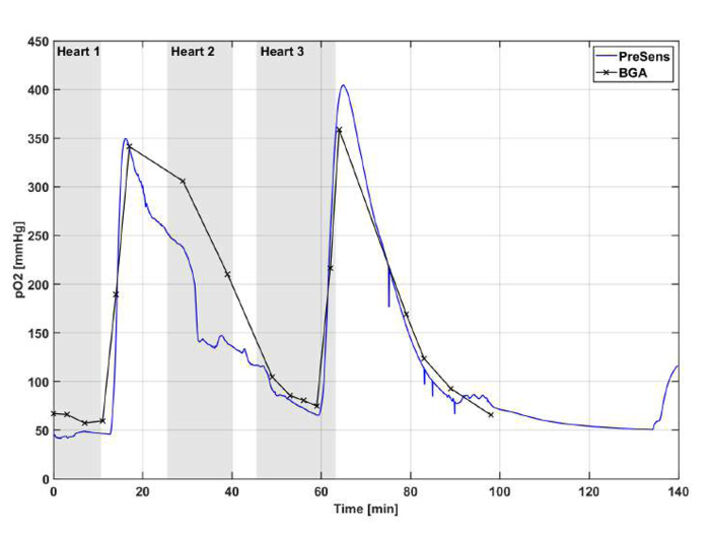
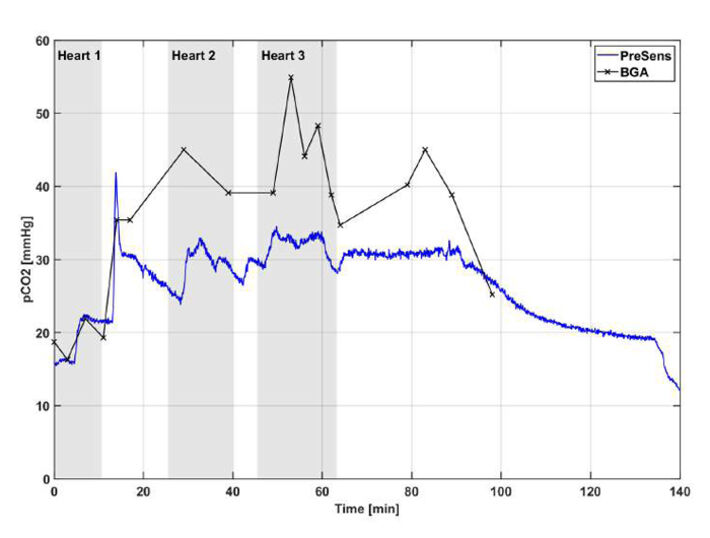
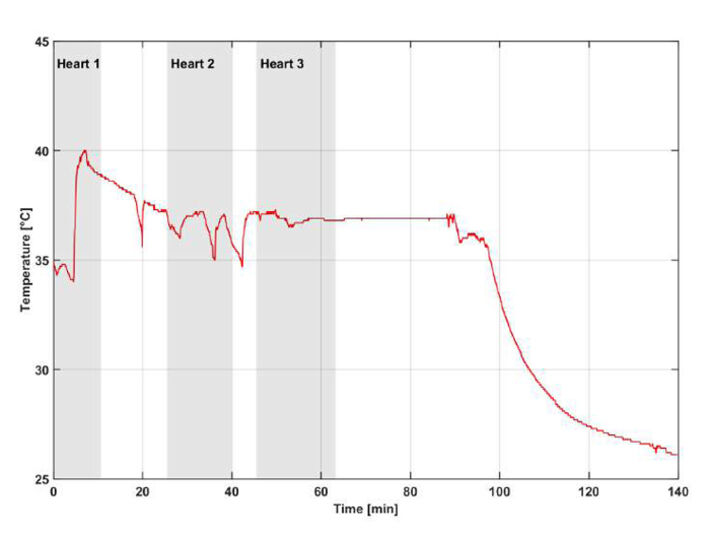
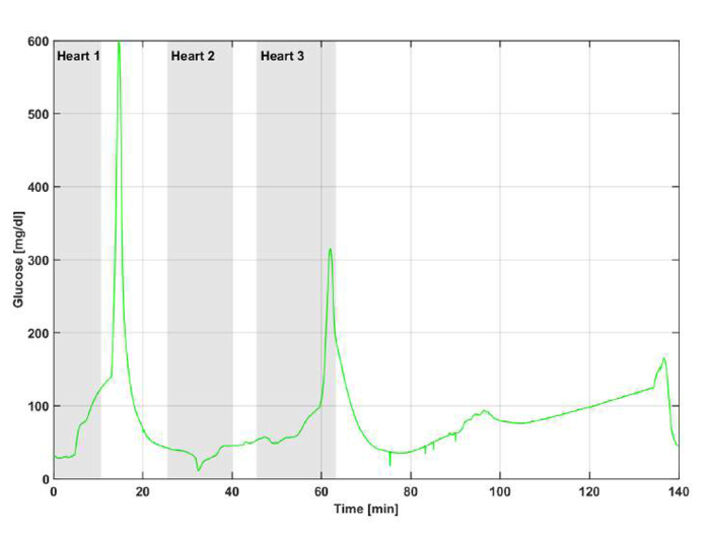
Conclusion
The PreSens sensors integrated in flow-through cells are a great addition to the test stand. The sensors ensure continuous data recording and allow swift intervention in case there is a deviation from physiological levels. However, there are still some deviations from the measurements with the BGA which still need to be clarified. In order to obtain statistically representative results, still several more experiments will have to be performed.

